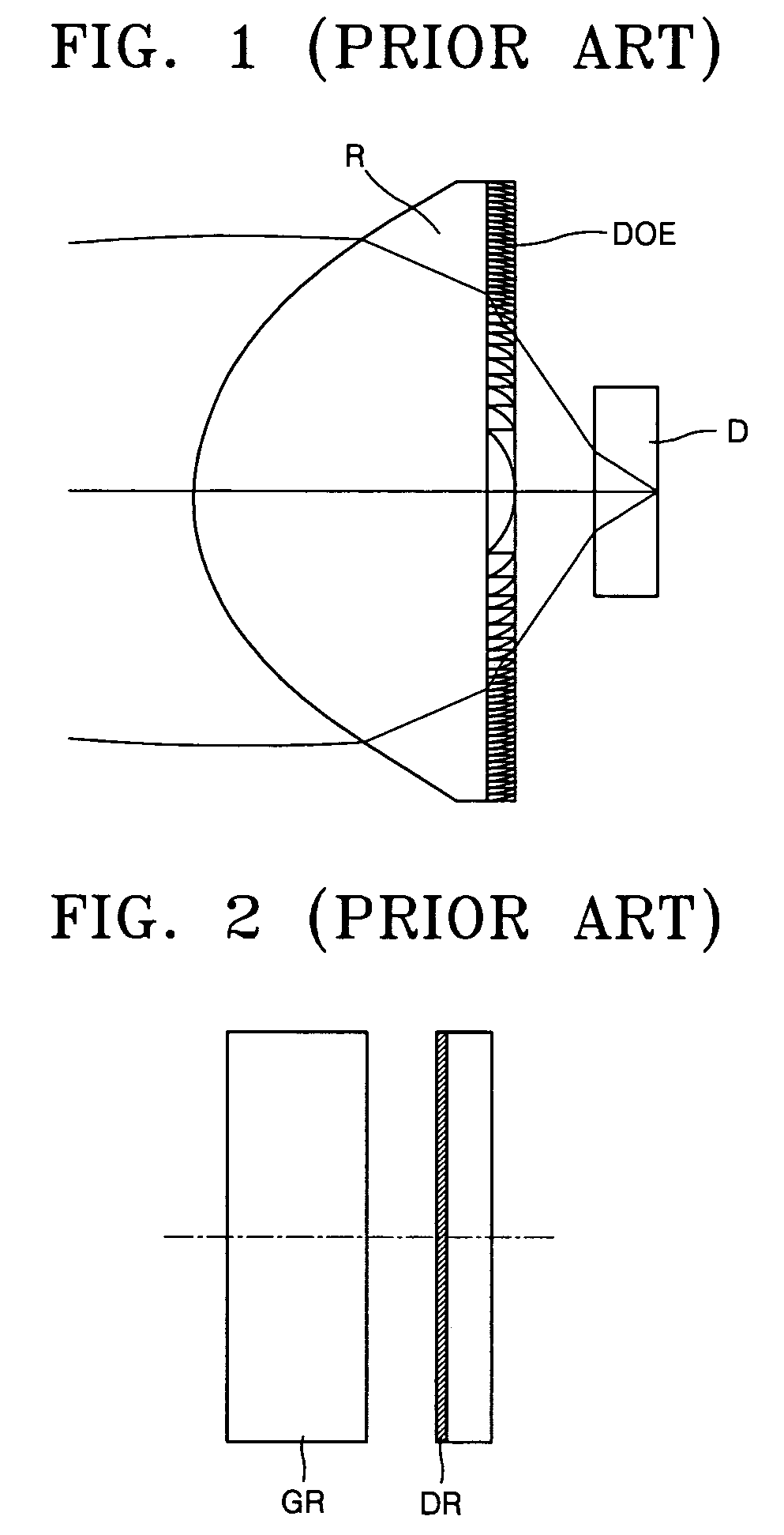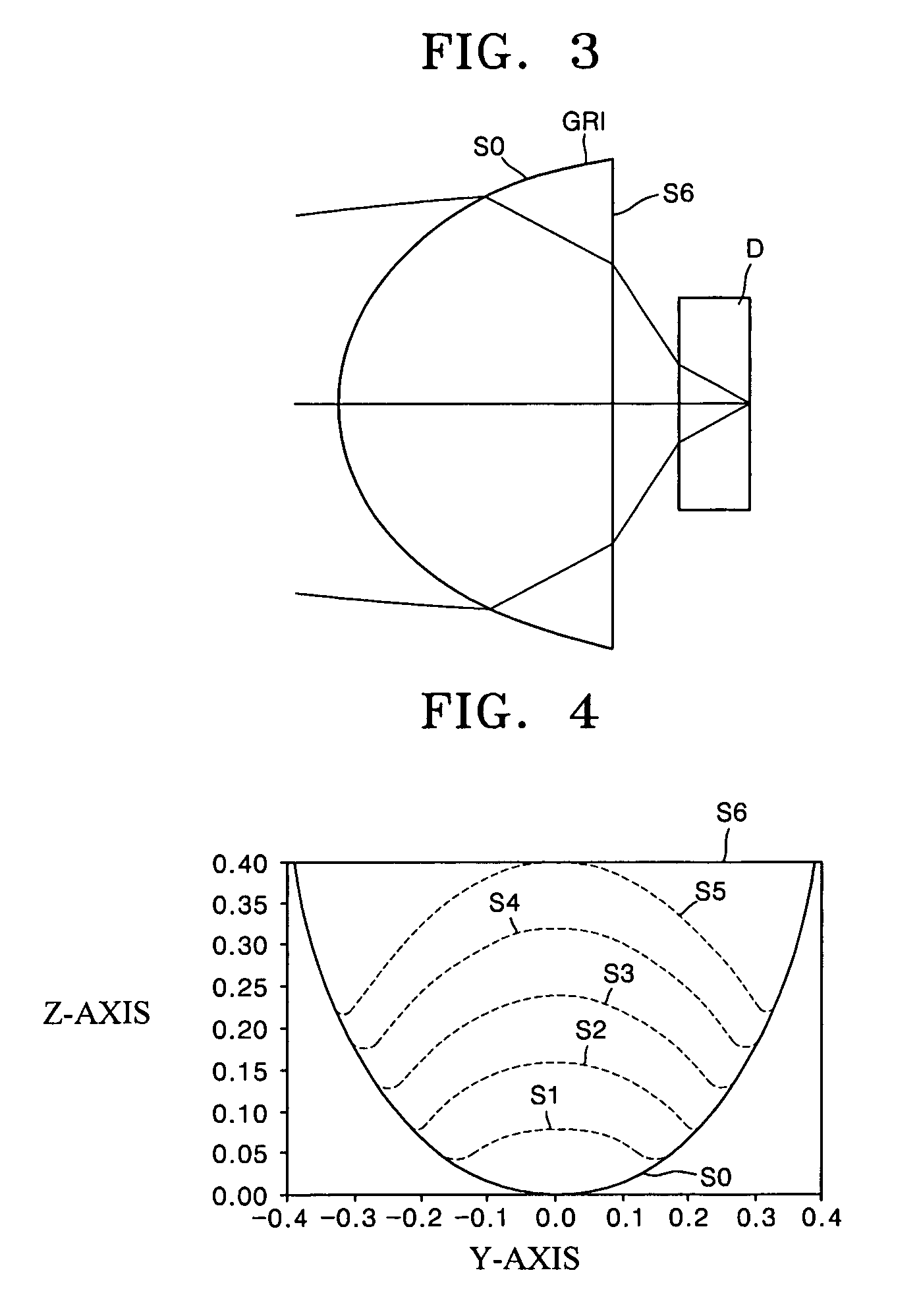Objective optical system employing grin lens
a technology of objective lenses and optical systems, applied in the field of objective optical systems employing gradient index lenses, can solve the problems of increasing the weight and size of objective optical systems, unable to meet the requirements of ultra-thin optical pickups, and the second method is limited in correcting the coma aberration generated in objective lenses, so as to achieve the effect of removing coma aberration and chromatic aberration, and ultra-small optical systems
- Summary
- Abstract
- Description
- Claims
- Application Information
AI Technical Summary
Benefits of technology
Problems solved by technology
Method used
Image
Examples
first embodiment
[0037]FIG. 3 is a schematic sectional view of an objective optical system according to the present invention. Referring to FIG. 3, the objective optical system employs a convex-plano gradient index (GRIN) lens GR1 as an objective lens. The GRIN lens GR1 forms a light spot having a desired size by focusing light on an optical disk D. The refractive index n of the GRIN lens GR1 may be changed as shown in Equations 4, 5 and 6. Equation 4 is equivalent to Equation 1, Equation 5 is equivalent to Equation 2 and Equation 6 is equivalent to Equation 3. A range of the refractive index n varies according to media from which the GRIN lens GR1 is made. It is preferable that the refractive index n is set in a range of a tolerance less than ±10%.
n(r, z)=n0+nr2r2+nr4r4+ . . . +nz1z+nz2z2+ [Equation 4]
n(z)=n0+n1z+n2z2+n3z3+n4z4+ [Equation 5]
n(r)=n0n2r2+n4r4+ [Equation 6]
[0038]In Equation 1 through Equation 6, z represents a distance from the center of the lens in an axial direction, and r repres...
second embodiment
[0044]FIG. 5 is a schematic sectional view illustrating a configuration of an objective optical system according to the present invention. Referring to FIG. 5, the objective optical system comprises a GRIN sheet lens GR2 having a refractive index n satisfying one of Equation 1 through Equation 3 (Equation 4 through Equation 6) and a plano-convex diffractive lens PCD having a planar incident surface sp and a convex emissive surface sd disposed in an optical path of light emitted from the GRIN lens GR2.
[0045]Since the emissive surface sd of the plano-convex diffractive lens PCD is a diffractive surface, the plano-convex diffractive lens PCD separates light refracted by the GRIN lens GR2 into a plurality of diffracted light beams including a zero-order light beam, a +1-order light beam, and −1-order light beam. Here, the plano-convex diffractive lens PCD may directly contact an emissive surface of the GRIN lens GR2 or may be spaced apart from the emissive surface of the GRIN lens GR2 b...
third embodiment
[0048]FIG. 7 is a schematic sectional view of an objective optical system according to the present invention. Referring to FIG. 7, the objective optical system includes a convex-plano refractive lens CPR having a convex aspherical incident surface si and a planar emissive surface so and a GRIN lens GR2 whose refractive index n(z) is changed in an axial direction according to Equation 2 which is equal to Equation 5. For example, when the convex-plano refractive lens CPR has a thickness of 0.4470 mm and an etching depth z of 0.272 mm from the aspherical surface, a clear aperture may be 2×0.418. The GRIN lens GR2 has a thickness of 0.1806 mm and a working distance between an optical disk D and the GR2 is 0.1 mm.
[0049]Table 1 shows the simulation results when using laser diodes emitting blue light beams of wavelengths 400 nm, 405 nm, and 410 nm to condense light using the objective optical system shown in FIG. 7, simulation results are shown in Table 1.
[0050]
TABLE 1Wavefront error (on / o...
PUM
 Login to View More
Login to View More Abstract
Description
Claims
Application Information
 Login to View More
Login to View More - R&D
- Intellectual Property
- Life Sciences
- Materials
- Tech Scout
- Unparalleled Data Quality
- Higher Quality Content
- 60% Fewer Hallucinations
Browse by: Latest US Patents, China's latest patents, Technical Efficacy Thesaurus, Application Domain, Technology Topic, Popular Technical Reports.
© 2025 PatSnap. All rights reserved.Legal|Privacy policy|Modern Slavery Act Transparency Statement|Sitemap|About US| Contact US: help@patsnap.com



